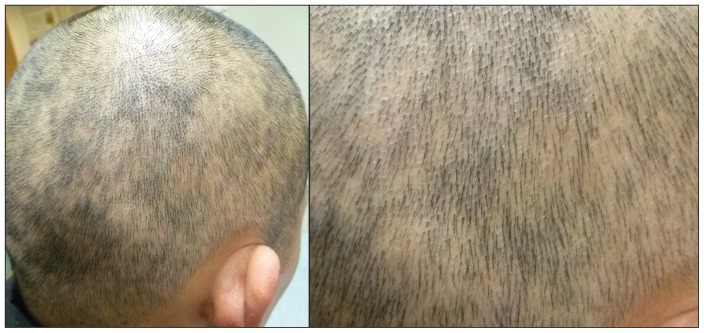A 39-year-old man presented with a three-month history of progressive hair loss on his scalp. Five months earlier, he had a generalized rash that lasted for three weeks. He reported having sexual intercourse without condoms with multiple female partners, but he had no history of genital ulceration. Examination revealed multiple patches of nonscarring alopecia, giving the scalp hair a “moth-eaten” appearance (Figure 1). His skin and mucosa appeared normal. The results of a rapid plasma reagin test were positive (titre 1:64) and Treponema pallidum agglutination was positive, supporting a diagnosis of syphilitic alopecia. He was given benzathine penicillin G via intramuscular injection. Five weeks later, hair regrowth began.
Figure 1:
A 39-year-old man with noncicatricial patchy alopecia over the scalp, giving it a moth-eaten appearance.
Syphilis is still “the great mimicker.” Although other concurrent clinical features of secondary syphilis (e.g., roseola syphilitica, mucous patches, condylomata lata, and ophthalmologic and auditory findings) may facilitate diagnosis,1 alopecia can be the only presenting feature of syphilis.2 Syphilitic alopecia can mimic alopecia areata both clinically and histopathologically;1,2 however, “exclamation point” hairs, a diagnostic clinical feature of alopecia areata, have not been described in syphilis. Tinea capitis can be noninflammatory and resemble moth-eaten syphilitic alopecia, but laboratory testing of scrapings should indicate the presence of fungus. Trichotillomania can also present with an appearance similar to moth-eaten alopecia, but this would be confirmed by history and findings of a biopsy.1,2
The frequency of hair loss in secondary syphilis ranges from 2.9% to 7%.1 The precise pathogenesis is unknown. The hair loss can be moth-eaten, diffuse or both. The “moth-eaten” pattern is the most common type and is considered to be a pathognomonic manifestation of secondary syphilis.1–3 The alopecia, which is nonscarring, can occasionally affect hair-bearing areas other than the scalp.1,3 The biopsy sample can be noninflammatory or show changes indistinguishable from alopecia areata.2T. pallidum is usually not seen with silver staining. The alopecia usually resolves within three months of appropriate treatment for syphilis.1
Footnotes
This article has been peer reviewed.
Competing interests: None declared.
References
- 1.Vafaie J, Weinberg JM, Smith B, et al. Alopecia in association with sexually transmitted disease: a review. Cutis 2005;76:361–6 [PubMed] [Google Scholar]
- 2.Bi MY, Cohen PR, Robinson FW, et al. Alopecia syphilitica-report of a patient with secondary syphilis presenting as moth-eaten alopecia and a review of its common mimickers. Dermatol Online J 2009;15:6. [PubMed] [Google Scholar]
- 3.Cuozzo DW, Benson PM, Sperling LC, et al. Essential syphilitic alopecia revisited. J Am Acad Dermatol 1995;32:840–3 [DOI] [PubMed] [Google Scholar]



